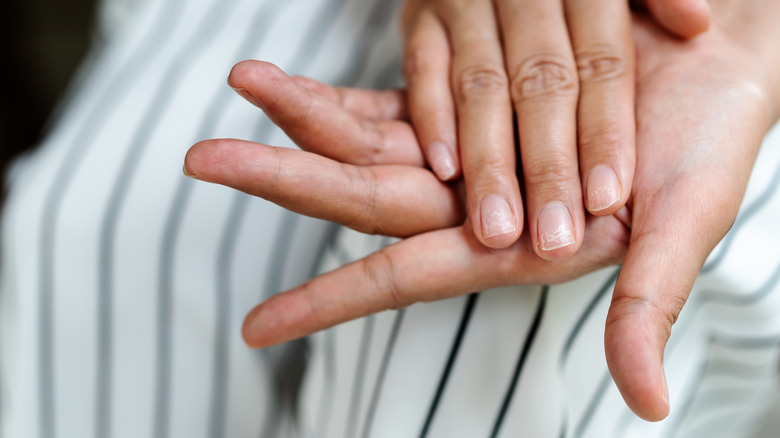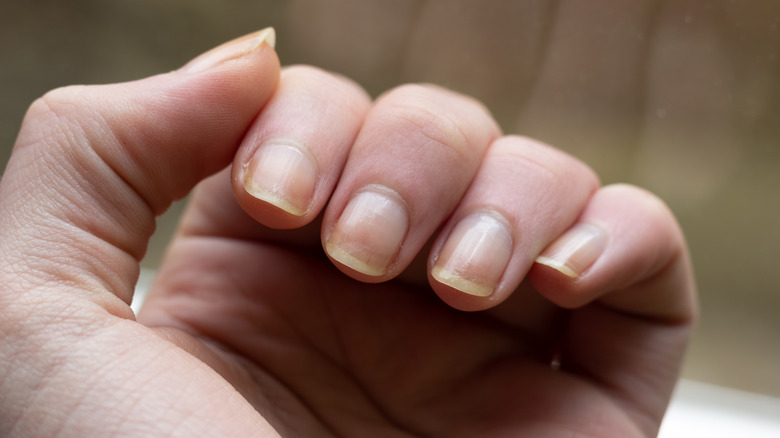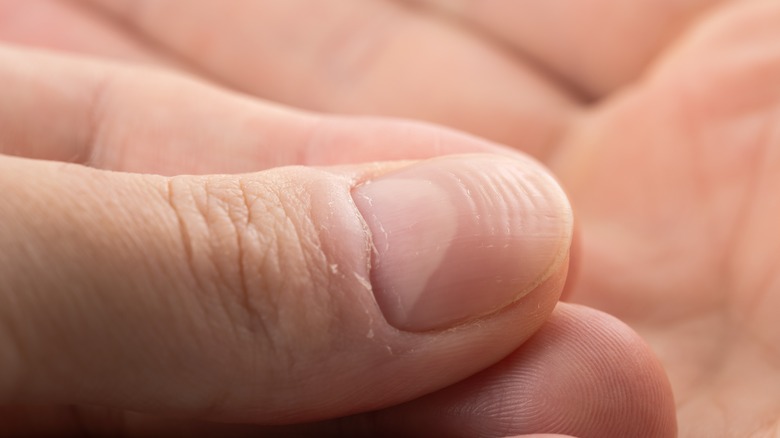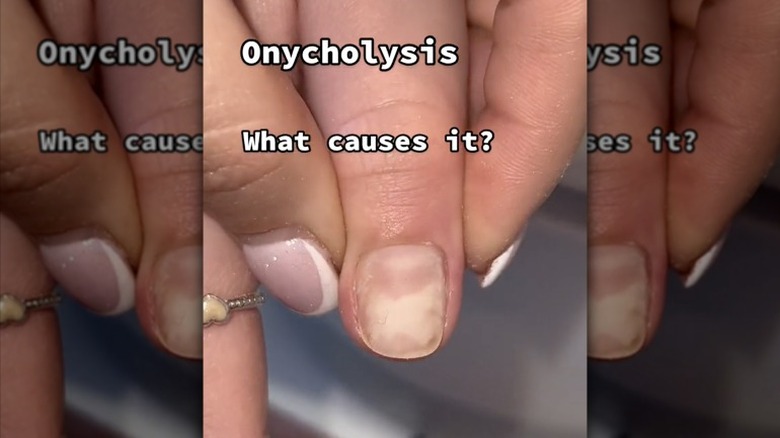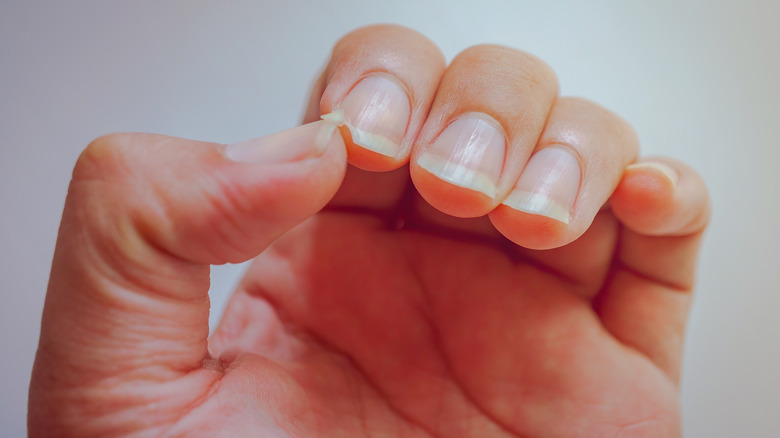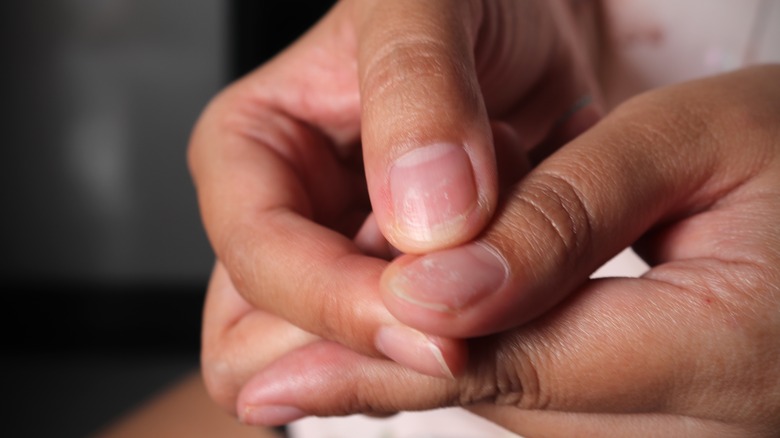Nail Changes You Should Never Ignore, According To Our Dermatologist
Nails are more than just a platform for us to show off all the hottest manicure trends — aside from protecting our fingertips and refining our fine-motor skills, our nails can also tell us vital information about the overall state of our health. In many cases, visible changes to the nails may be down to innocent and temporary causes, such as stains from nail polish or weakness and thinness from repeated acrylic or Gel-X manicures. But it's important to pay attention to your nail changes carefully, since they may indicate a larger health problem.
In an exclusive interview with Glam, board-certified dermatologist Dr. Jenny Liu, FAAD, explains that the most important nail changes to look out for include changes in color, the appearance of grooves or horizontal lines, thickening or lifting of the nails, nail splitting, and the appearance of small pits on the nails. Dr. Liu reveals that these may point to vitamin deficiencies, infections, or skin conditions such as eczema and psoriasis. However, they can sometimes indicate much more serious ailments, including thyroid issues, circulatory diseases, and even skin cancer.
Watch out for color changes
Changing nail color is one of the most easy-to-spot and common signs that you may be dealing with a health issue. "Yellow nails, for instance, may indicate fungal infections, psoriasis, or thyroid issues," Dr. Jenny Liu confirms in an exclusive chat with Glam. "Blue nails can indicate a lack of oxygen in the blood, potentially signaling lung or heart problems." Dr. Liu warns that while white spots are often a sign of zinc deficiency or trauma to the nail, they can also point to a more serious condition, such as liver disease. "Lastly, if it's true pigment, it could be skin cancer like melanoma that usually is a band of dark brown/black," she adds.
If you're a frequent nail polish wearer, you may find that your nails are stained yellow after you remove the polish, and stay that way until new growth comes in. So a color change isn't an immediate sign to panic, but because of the potential serious nature of changes in nail color, it's always a good idea to check in with your doctor if you notice significant discoloration.
Horizontal nail grooves can point to underlying issues
Nail grooves are common, but in some cases, they may also be a sign of a deeper underlying problem, according to Dr. Jenny Liu. "Beau's lines are deep grooves or indentations that run horizontally across the nails," she tells Glam exclusively. "They can occur due to severe illness, malnutrition, or trauma to the nail matrix." In particular, circulatory diseases, high fever, and uncontrolled diabetes can cause Beau's lines, Dr. Liu shares.
Not to be confused with the harmless yet unsightly vertical ridges which often appear on your nails as you age, horizontal Beau's lines can come about as a result of chemotherapy. They may also point to respiratory diseases, acute kidney disease, syphilis, and mumps. While you can sometimes gently buff ridges away if they aren't a sign of underlying illness, horizontal nail grooves — particularly those that appear on all 20 of your nails — are definitely worth a visit to the doctor.
Nail lifting may be a sign of trauma
While many of us dream of thicker, harder, and stronger nails, too much thickening — to the point where the nail lifts from the bed — is actually a sign of a problem. In an exclusive interview with Glam, Dr. Jenny Liu explains that this phenomenon is called onycholysis and often occurs as a result of infection, lichen planus or psoriasis. "Onycholysis, where the nail lifts from the nail bed, can be due to trauma, fungal infections, or allergic reactions," she says, adding that the lifting itself can lead to further problems as it leaves the nail bed open to infection.
In many cases, onycholysis appears on just one nail and is more common amongst adult women. Along with the common medical causes, it can occur after taking certain medications, or after exposure to particular chemicals. It usually isn't painful, but important to address so that any underlying health problems can be addressed, too.
Don't ignore splits in your nails
If your nails have repeatedly been exposed to abrasive chemicals or have experienced another kind of trauma, you may end up with onychorrhexis. This presents as vertical ridges and splits in the nails, and may also be caused by repeated exposure to water. "It may also be a sign of vitamin deficiencies, particularly biotin, or chronic conditions like psoriasis and eczema," Dr. Jenny Liu explains to Glam exclusively.
A common condition, onychorrhexis is often just a sign of aging and no cause for concern. But severely splitting nails can also reveal much more about your health, including the presence of conditions such as anemia, systemic sclerosis, eating disorders, and osteoarthritis. If you've recently had a bone marrow transplant, onychorrhexis can also be a sign of graft versus host disease. Though onychorrhexis can be a harmless sign of aging, you'll still want to get prevalent vertical ridges or splitting assessed by a healthcare provider to rule out any of the potential underlying causes.
If you need help with an eating disorder, or know someone who does, help is available. Visit the National Eating Disorders Association website or contact NEDA's Live Helpline at 1-800-931-2237. You can also receive 24/7 Crisis Support via text (send NEDA to 741-741).
Psoriasis or eczema can lead to nail pitting
In an exclusive conversation with Glam, Dr. Jenny Liu shares that nail pitting "refers to small depressions or indentations on the nail surface and is commonly associated with psoriasis, eczema, or alopecia areata." This is usually easy to identify, presenting as small "pits" in your nails. "It occurs due to abnormal development of the layers of the nail plate," Dr. Liu notes.
Nail pitting can occur both in your fingernails and your toenails, and when it appears as a symptom of psoriasis, it is often accompanied by nail discoloration and a change to the shape of your nails. The condition can affect anyone, though it's more prevalent in those aged over 40, and may also be a sign of reactive arthritis or osteoarthritis, and atopic or contact dermatitis. Your healthcare provider will likely perform a physical exam and may take a biopsy to find the underlying cause of your nail pitting, and then prescribe treatment based on that cause. Some of the most common treatment options for nail pitting include phototherapy, corticosteroid injections, and immunosuppressant medications.
